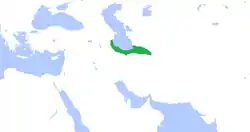Dabuyid dynasty
The Dabuyid dynasty, or Gaubarid dynasty, was a Zoroastrian[2] Iranian dynasty that started in the first half of the 7th century as an independent group of rulers that ruled over Tabaristan and parts of western Khorasan.[3] Dabuyid rule over Tabaristan and Khorasan lasted from around 642 to the Abbasid conquest in 760.
Dabuyid dynasty | |||||||||||||||
|---|---|---|---|---|---|---|---|---|---|---|---|---|---|---|---|
| 642–760 | |||||||||||||||
 The Dabuyid dynasty around its greatest extent under Farrukhan the Great | |||||||||||||||
| Capital | Fuman (660–760)[1] | ||||||||||||||
| Common languages | Middle Persian, Caspian languages, Tabari | ||||||||||||||
| Religion | Zoroastrianism | ||||||||||||||
| Government | Monarchy | ||||||||||||||
| Ispahbadh | |||||||||||||||
• 640-660 | Gil Gavbara (first) | ||||||||||||||
• 740/41-759/60 | Khurshid (last) | ||||||||||||||
| Historical era | Middle Ages | ||||||||||||||
| 642 | |||||||||||||||
• Abbasid conquest | 760 | ||||||||||||||
| |||||||||||||||
| Today part of | Azerbaijan Iran Turkmenistan | ||||||||||||||
| History of Iran |
|---|
 |
|
Timeline |
History
The family's early history is recorded by the later historian Ibn Isfandiyar. According to that tradition, the Dabuyids were descended from Jamasp, a son of Sassanid King of Kings Peroz I and younger brother of Kavadh I, and were therefore a cadet branch of the House of Sasan. Jamasp's grandson, Piruz, conquered Gilan, and a relative of Piruz, Gil, nicknamed Gavbara (literally Devotee of the Cow), then extended the family's rule by annexing Tabaristan. That led to the formal conferment of the titles of Gil e Gilan ("ruler of Gilan") and Padashwargarshah ("King of Patashwargar", the older name of Tabaristan's mountains), to Gil's son Dabuya or Daboe, by the last Sassanid King of Kings, Yazdegerd III.
After the Muslim conquest of Persia, that Sassanian cadet branch, along with the dynasts of the noble houses of Ispahbudan and Karin, signed peace treaties with the Arab armies by which the Arabs never to approach those territories without prior permission. Consequently, the regions of Gilan and at least parts of Tabaristan remained under Gavbara's control, and Rey and parts of Khorasan were ruled by Farrokhzad of House of Ispahbudan.[4] After about 15 years, Ibn Isfandiyar reports that Gavbara died and his son Dabuya succeeded the throne, hence the name given to the dynasty. Dabuya's son, Farrukhan the Great was successful in taking over Tabaristan up to the frontiers of Nishapur after years of dynastic struggle between the Houses of Karin and Ispahbudan in north-eastern Iran. In addition to the titles granted by Yazdegerd III, the Dabuyid rulers also bore the old Iranian military title of ispahbadh as their regnal title.
Farrukhan the Great repelled a great Muslim invasion under Yazid ibn al-Muhallab in 716–717,[5] Recent scholarship places his assumption of power there in the 670s, instead of the early 710s, as previously assumed. Farrokhan died in 728 and was succeeded by his son, Dadhburzmihr (Dadmihr). Little is known of his reign, and he died at an early age in 740/741. Dadmihr's son and successor, Khurshid, was still a boy when he was crowned Ispahbadh of Tabaristan, which required his uncle Farrukhan the Little to rule as regent for seven years until Khurshid came of age. Khurshid ruled a prosperous state and attempted repeatedly to break his ties to the caliphate.
After the turmoil of the Abbasid Revolution, a serious conflict ensued between Khurshid and Abbasid Caliph Al-Mansur. In 759, Al-Mansur used a ruse to launch a campaign against the Dabuyid dynasty. He sought Khurshid's aid in subduing a rebellion in Khorasan by allowing Al-Mansur's forces to pass through Tabaristan. Khushid permitted that but was faced with a surprise attack, which led to the invasion and the subsequent fall of Tabaristan. The fleeing Khurshid took refuge in Gilan, where he attempted to reinforce for a counter-attack but after the capture of the royal, he family committed suicide in 761, which ended the reign of the Dabuyid dynasty.[4]
Dabuyid rulers
- Gil Gavbara (640-660)
- Dabuya (660-676)
- Farrukhan the Great (712-728)
- Dadhburzmihr (728-740/41)
- Farrukhan the Little (740/41-747/48) as regent for
- Khurshid (741-759/60)
References
- Bazin, Marcel (2000). "FŪMAN". Encyclopaedia Iranica, Vol. X, Fasc. 3. pp. 227–228.
- C.E. Bosworth, The New Islamic Dynasties, (Columbia University Press, 1996), 162; "Hence in 758 the caliph undertook the definitive conquest of Tabaristan, successfully drove out Khurshid II and ended the dynasty of the Dabuyids (who, as Zoroastrians, had never accepted Islam)".
- DABUYIDS, W. Madelung, Encyclopaedia Iranica
- Pourshariati, Parvaneh (2008). Decline and Fall of the Sasanian Empire: The Sasanian-Parthian Confederacy and the Arab Conquest of Iran. London and New York: I.B. Tauris. pp 287-318. ISBN 978-1-84511-645-3.
- "Dabuya", B. Spuler, The Encyclopaedia of Islam, Vol. II, ed.B. Lewis, C. Pellat and J. Schacht, (Brill, 1991), 74.
Sources
- Inostranzev, M. (1918) Iranian Influence on Moslem Literature – Appendix I: Independent Zoroastrian Princes of Tabaristan.
- Madelung, Wilferd (1993). "DABUYIDS". In Yarshater, Ehsan (ed.). Encyclopaedia Iranica, Vol. VI, Fasc. 5. London u.a.: Routledge & Kegan Paul. pp. 541–544. ISBN 1-56859-007-5.
- Pourshariati, Parvaneh (2008). Decline and Fall of the Sasanian Empire: The Sasanian-Parthian Confederacy and the Arab Conquest of Iran. London and New York: I.B. Tauris. ISBN 978-1-84511-645-3.
- Yavari, Neguin (2020). "Dābūyids". In Fleet, Kate; Krämer, Gudrun; Matringe, Denis; Nawas, John; Rowson, Everett (eds.). Encyclopaedia of Islam (3rd ed.). Brill Online. ISSN 1873-9830.

